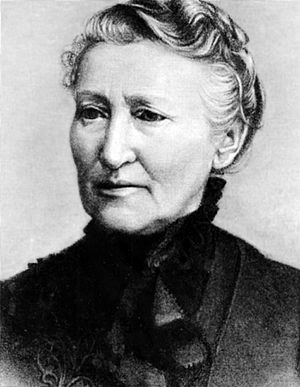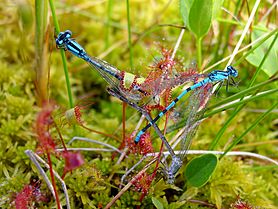Mary Treat para niños
Datos para niños Mary Treat |
||
|---|---|---|
 |
||
| Información personal | ||
| Nombre de nacimiento | Mary Lua Adelia Davis | |
| Nacimiento | 7 de septiembre de 1830 Trumansburg (Estados Unidos) |
|
| Fallecimiento | 11 de abril de 1923 (92 años) Pembroke (Estados Unidos) |
|
| Sepultura | Nueva Jersey | |
| Nacionalidad | Estadounidense | |
| Información profesional | ||
| Ocupación | Botánica, zoóloga, entomóloga, recolector de plantas y escritora | |
| Área | Botánica y entomología | |
| Abreviatura en botánica | Treat | |
| Abreviatura en zoología | Treat | |
Mary Lua Adelia Davis Treat (7 de septiembre de 1830, Trumansburg, Nueva York – 11 de abril de 1923, Pembroke, Nueva York) fue una naturalista y corresponsal con Charles Darwin. Las contribuciones de Treat, tanto a la botánica como entomología fueron extensas: cuatro especies de plantas y de animales llevan su epónimo, incluida una amaryllis, Zephyranthes treatae (hoy llamado Zephyranthes atamasca var. treatae), y una especie de hormiga: Aphaenogaster treatae.
Contenido
Biografía
Nacida Mary Davis de una familia de clase media,, en Trumansburg, Nueva York, creció principalmente en Ohio, donde asistió a escuelas públicas y privadas de niñas. Davis se casó, en 1863, con el Dr. Joseph Burrell Treat, un abolicionista y profesor; vivieron en Iowa y en 1868 se mudaron a Vineland, Nueva Jersey.
Carrera e investigaciones
Después de mudarse a Nueva Jersey, Treat comenzó estudios científicos; y, colaboró con su esposo en artículos e investigaciones sobre entomología. El primer artículo científico de Treat fue publicado en "The American Entomologist" cuando tenía 39 años. Y, durante 28 años escribió 76 artículos científicos y de divulgación popular, así como cinco libros. Su investigación se expandió rápidamente desde entomología a la ornitología y botánica, detallando la vida de aves y de plantas en la región sur de Nueva Jersey.. En 1874, siguiendo a la separación con su esposo, Treat se sustentó a sí misma mediante la publicación de artículos de divulgación científica popular en publicaciones periódicas como Harpers and Queen. A partir de 1870, publicó artículos populares naturalistas en Garden and Forest, Hearth and Home, Harper's, y en Lippincott's.
Su texto, Injurious Insects of the Farm and Field, originalmente publicado en 1882, fue reimpreso cinco veces. Recolectó plantas e insectos para otros investigadores, uno de los cuales fue el eminente botánico de Harvard Asa Gray. Fue a través de Gray que le presentaron a Charles Darwin. Treat escribió notas para participar en discursos botánicos y entomológicos, no solo con Darwin y Gray, sino también a Auguste Forel y a Gustav Mayr. Viajó a Florida varias veces entre 1876 y 1878 para investigar más plantas insectívoras. En uno de esos viajes, descubrió el lirio Zephyranthes treatae (nombrado en su honor por Sereno Watson) y descubrió que otro lirio no estaba extinto.
Colaboración con Charles Darwin
La primera correspondencia registrada entre Treat y Darwin data del 20 de diciembre de 1871, en la que Treat describe las actividades de captura de moscas de Drosera, comúnmente conocidas como plantas de drosera. La correspondencia registrada de Treat y Darwin se extiende a lo largo de cinco años alrededor del período en el que Darwin investigaba y luego publicaba sobre plantas carnívoras. Hablan predominantemente de estas plantas en su correspondencia, y Treat criticó abiertamente las hipótesis de Darwin. Un intercambio notable tuvo que ver con la planta vejiga, Utricularia clandestina.
El maestro y mentor de Darwin en Cambridge, John Stevens Henslow, tenía una comprensión clara de la morfología de las plantas Utricularia (bladderwort), pero no era capaz de comprender la mecánica de funcionamiento de sus trampas. Darwin concluyó incorrectamente que los animales entraban en las trampas forzando sus cabezas a través del orificio en forma de hendidura con sus cabezas sirviendo como cuña. En una carta a Treat, le informó que este tema lo volvía "medio loco". Treat quedó profundamente absorto en este problema, investigando intensamente. Tras largas horas de observación de la secuencia de captura bajo su microscopio , se dio cuenta de que los pelos alrededor de la entrada de la trampa eran sensibles y formaban parte del proceso mediante el cual se abrían las trampas de Utricularia , aportando nuevos conocimientos sobre la variedad de presas animales microscópicas atrapadas en estas trampas y los procesos digestivos a los que fueron sometidos. Treat lo describió como "estas pequeñas vejigas ... en verdad, como otros tantos estómagos, que digieren y asimilan alimentos animales". Darwin quedó tan impresionado con el trabajo de Treat sobre plantas carnívoras que hizo referencia a ella, tanto en el texto principal como en las notas a pie de página, a lo largo de su publicación Plantas insectívoras (1875).
Al hacer tales afirmaciones públicas sobre el trabajo científico de Treat, Darwin legitimó su papel como científica, aunque esto no está completamente aceptado entre los historiadores. Con la llegada de Internet, la correspondencia de Treat con Darwin se ha analizado con más detalle.
Legado
El mejor archivo de la vida de Treat está disponible en la Sociedad Histórica y Anticuaria de Vineland. Además, en 2022 se publicó la primera biografía definitiva completa de Treat, Mary Treat: una biografía de Deborah Boerner Ein.
El herbario de la Universidad de Harvard tiene una selección de especímenes de Treat enviados a Asa Gray y ejemplos de su correspondencia original. Las cartas originales están, en su mayoría, disponibles para ver a través de The Darwin Correspondence Project y en la Biblioteca de la Universidad de Cambridge.
La hormiga Aphaenogaster Treatae recibió el nombre de Treat del entomólogo suizo Auguste Forel en honor a su descubrimiento de especímenes de hormigas en Florida y Nueva Jersey. El entomólogo austriaco Gustav Mayr nombró a una avispa de la raíz de la higuera del roble (cinípida), Belonocnema treatae, en honor a Treat después de que ella la descubriera en un roble de Virginia en Florida.
Mary Treat fue mencionada como uno de los personajes principales de la novela histórica Unsheltered de 2018, de la escritora estadounidense Barbara Kingsolver, quien se tomó libertades en su interpretación de Treat y Vineland, Nueva Jersey del siglo XIX.
Obra
Muchas de las obras de Treat detallan sus observaciones de insectos y aves en un estilo accesible a una audiencia popular.
- Capítulos sobre hormigas (1879)
- Insectos nocivos de la granja y el jardín (1882)
- Inicio Estudios de la naturaleza (1885)
- A través de un microscopio (1886)
- Mis mascotas de jardín (1887)
- Asa Gray: su vida y obra (1890)
Véase también
 En inglés: Mary Treat Facts for Kids
En inglés: Mary Treat Facts for Kids
- Cronología de la mujer en la ciencia


